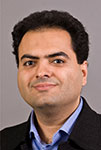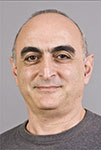Improving the efficiency of hydraulic fracturing treatment in CBM reservoirs by stimulating the surrounding natural fracture system
Alireza Keshavarz A , Alexander Badalyan B , Raymond JohnsonA Australian School of Petroleum, The University of Adelaide
B The University of Adelaide
C Unconventional Reservoir Solutions; The University of Adelaide
The APPEA Journal 55(1) 351-360 https://doi.org/10.1071/AJ14028
Published: 2015
Abstract
A method is proposed for enhancing the conductivity of micro-fractures and cleats around the hydraulically induced fractures in coal bed methane reservoirs. In this technique, placing ultra-fine proppant particles in natural fractures and cleats around hydraulically induced fractures at leak-off conditions keeps the coal cleats open during water-gas production, and this consequently increases the efficiency of hydraulic fracturing treatment.
Experimental and mathematical studies for the stimulation of a natural cleat system around the main hydraulic fracture are conducted. In the experimental part, core flooding tests are performed to inject a flow of suspended particles inside the natural fractures of a coal sample. By placing different particle sizes and evaluating the concentration of placed particles, an experimental coefficient is found for optimum proppant placement in which the maximum permeability is achieved after proppant placement.
In the mathematical modelling study, a laboratory-based mathematical model for graded proppant placement in naturally fractured rocks around a hydraulically induced fracture is proposed. Derivations of the model include an exponential form of the pressure-permeability dependence and accounts for permeability variation in the non-stimulated zone. The explicit formulae are derived for the well productivity index by including the experimentally found coefficient.
Particle placement tests resulted in an almost three-times increase in coal permeability. The laboratory-based mathematical modelling, as performed for the field conditions, shows that the proposed method yields around a six-times increase in the productivity index.

Alireza Keshavarz studied petroleum engineering at the Petroleum University of Technology (PUT) in Tehran for his first university degree. He continued his studies as a postgraduate student in hydrocarbon reservoir engineering at the University of Tehran, and finished his master’s degree in 2007. Alireza then worked for six years for the National Iranian Oil Company (NIOC) as a reservoir engineer. Alireza is now a final-year PhD candidate in the Petroleum Engineering department at the University of Adelaide. |

Alexander Badalyan is a Senior Research Associate in the Australian School of Petroleum at the University of Adelaide. His research interests include: suspension flow in porous media; characterisation of porous solids by manometric gas adsorption; application of supercritical and liquid CO2 for the extraction of essential oils; dissolved gas-in-oil analysis for condition monitoring of power transformers; and, the thermophysical properties of gases and liquids. Alexander is the co-author of one Australian patent, and is the author/co-author of one book chapter, 24 peer-reviewed publications in international journals, eight international conference papers, and 21 conference presentations. He holds a bachelor’s degree in automatic control from Grozny Petroleum Institute (USSR), and a PhD in the theoretical fundamentals of heat engineering (thermal properties of fluids) from Azerbaijan Petroleum and Chemistry Institute (USSR). |

Raymond (Ray) Johnson, Jr. is a principal at Unconventional Reservoir Solutions, adjunct associate professor at the University of Adelaide and adjunct fellow at the University of Queensland. He has a PhD in mining engineering, MSc in petroleum engineering, a graduate diploma in information technology and a BA in chemistry. Ray has been active in the SPE, he is a past chair of the SPE Queensland Section, 2013 co-chair of the SPE Unconventional Reservoir Conference and Exhibition Asia Pacific and he will be the 2015 co-chair of the SPE Unconventional Reservoir Conference and Exhibition Asia Pacific. Member: SPE, PESA, SPWLA, ISRM, AusIMM. |

Pavel Bedrikovetski is author of two books in reservoir engineering and has published 150 technical papers in international journals and SPE. His research covers formation damage and IOR. He holds MSc in applied mathematics, PhD in fluid mechanics and DSc in reservoir engineering from Moscow Oil-Gas Gubkin University. In 1991–94 he was a visiting Professor at Delft University of Technology and at the Imperial College of Science and Technology. Since 1994 Pavel has been a Petrobras staff consultant. He holds the Chair in Petroleum Engineering at the University of Adelaide. He has served as section chairman, short course instructor, key speaker and steering committee member at several SPE Conferences. He was 2008–09 SPE Distinguished Lecturer. |


